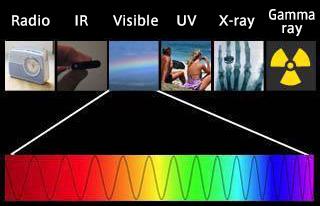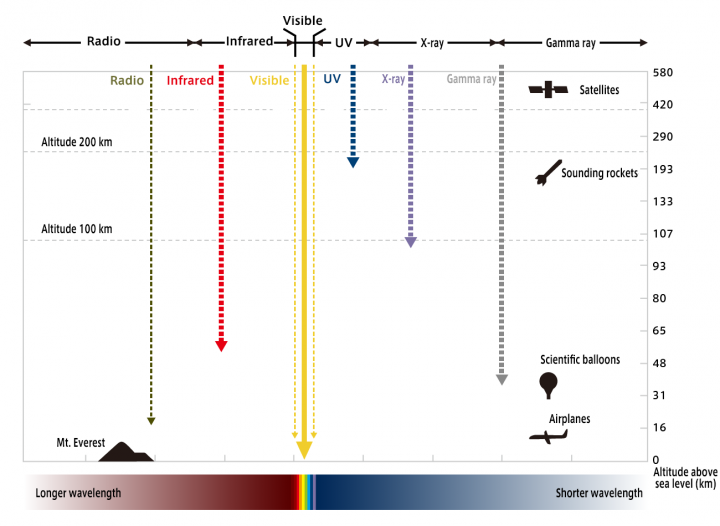Does the Sun Emit Invisible Light that We Can't See?
What color is sunlight? When you think about a rainbow, you can understand that sunlight contains various colors from red to purple. This is because the rainbow is sunlight which has been dispersed by the water drops in the air. But, sunlight is not only the light from red to purple. Infrared and ultraviolet rays are also included in the sunlight. Our eyes can't see the infrared and the ultraviolet rays.
Red light, purple light, as well as infrared and ultraviolet rays, these are all light (electromagnetic waves). What is the difference between them?
The answer is wavelength. Light is a wave. The distance between adjacent peaks is called the wavelength. As shown in the image, the light from red to purple is seen in rainbows; the longer wavelength is red, and the shorter is purple. We cannot see light whose wavelength is longer than red or shorter than purple. Infrared rays and radio waves have longer wavelengths than red does. On the other hand, ultraviolet rays, X-rays, and gamma rays have wavelengths shorter than purple. All of these wavelengths are included in sunlight.

Light Wavelengths
( ISAS / JAXA)
What We Understand from Colors
Dispersing light into different wavelengths (colors) is called spectroscopy. The strength of the light by wavelength is called a spectrum. Sometimes "emission lines" or "absorption lines" may appear in the spectrum. "Emission lines" and "absorption lines" are also called "spectral lines." Spectral lines are very important for solar observation, so we will explain them here.
How Spectrum Lines Appear
Emission lines and absorption lines appear when the atoms or ions absorb or emit light of a characteristic wavelength determined by the type of atom/ion. For example, when you take the spectrum of a sodium lamp, a strong "emission line" containing only orange light (wavelength 590 nm) appears. This is because the sodium emits this orange light. It also absorbs the same wavelength of light. Therefore, when there is a more intense light source on the far side of the sodium lamp, the sodium gas in the lamp absorbs more light from the background than the gas itself emits towards the viewer. As a result, if you analyze the spectrum you find that only the orange light has a net drop, creating an "absorption line" with lower intensity than other regions. This is because, among the light emitted from the light source, only this wavelength is absorbed by sodium; other wavelengths are not absorbed and reach the observer with their original strengths. The orange light absorbed by sodium is reemitted by the sodium. But if the temperature of the gas is low at that time, then the emission intensity weakens. In addition the reemitted light is emitted in all directions, not just the direction in which the original light was incident. Therefore, the amount of light reaching the observer is relatively weak compared to the other wavelengths of light.
You Can See the Atmospheric Layers of the Sun Separately
For the Sun, it is thought that calcium ions mainly emit in the chromosphere. Since ionized calcium absorbs and emits purple light of 396.9 nm, an absorption line appears at 396.9 nm when you analyze the spectrum of the chromosphere backlit by the photosphere. And if you observe the edge of the Sun without the photosphere in the background, an emission line will appear at 396.9 nm. Regardless of whether you are observing it as an emission line or as an absorption line, if you observe the Sun through a filter that transmits only this spectral line (purple light of wavelength 396.9 nm), you can see the chromosphere. Likewise, the light emitted by the CH molecule (wavelength 430.8 nm, G band) allows you to see the upper part of the photosphere. Since the high temperature corona emits many short wavelength ultraviolet rays and X-rays, in order to see the corona, we should observe those wavelengths.
Light is Absorbed by the Earth's Atmosphere Depending on the Wavelength
When we want to see the corona, we should observe the Sun in ultraviolet rays and X-rays, but we cannot observe these from the Earth. This is because ultraviolet and X-rays emitted from the Sun are absorbed by the Earth's atmosphere. You might think that ultraviolet rays reach the Earth's surface because you get sunburned by ultraviolet rays. It is true that some ultraviolet rays reach the ground, but they are only a small remainder of the radiation absorbed by the atmosphere and they are only the near ultraviolet rays which have relatively long wavelengths for ultraviolet. Life on our Earth is protected from harmful ultraviolet rays and X-rays by the atmosphere's absorption. However, when you observe the corona in ultraviolet rays or X-rays for research purposes, you have to go outside the atmosphere, to outer space, in order to observe it. So, this is a job for solar observation satellites.
Observations from Outer Space Aren't Affected by Atmospheric Fluctuations
Visible red-to-purple light (visible light) reaches the surface of the Earth without being absorbed by the Earth's atmosphere. Nonetheless, there is a Solar Optical Telescope on the Hinode satellite. Why do we need to take the Solar Optical Telescope to outer space? Please look at the movie below. The solar surface movie taken with the ground-based telescope is blurred, but the one taken with Hinode is very clear. The ground based movie blurs due to atmospheric fluctuations like heat haze. But, from outer space, where there aren't effects from atmospheric fluctuations, we can observe with long term stability in the resolution.
Comparison of movies by Hinode (left) and a ground-based telescope (right)
(© NAOJ / JAXA / SST)
Regarding the use of images and movies on the page concerned, please visit the page here. The credits of images and movies on this page are “NAOJ/JAXA” unless explicitly stated to the contrary. Regarding images and movies on this page the credits of which are “NAOJ/JAXA”, "NAOJ/JAXA/MSU", or “NAOJ, JAXA, NASA/MSFC”, terms of use for Copyrighted Works owned by NAOJ can be applied. In using the images and movies, the credits should be given.

